Geochronology and Tectonic Implications of the Nianzigou Granites and Associated Mo Deposit, Inner Mongolia
Abstract
:1. Introduction
2. Geological Setting
3. Ore Deposit Geology
4. Samples and Analytical Methods
4.1. Zircon U-Pb Dating
4.2. Molybdenite Re-Os Dating
4.3. Whole-Rock Major- and Trace-Element Geochemistry
5. Results
5.1. Zircon U-Pb Ages
5.2. Molybdenite Re-Os Dating
5.3. Whole-Rock Geochemistry
6. Discussion
6.1. Classification of the Nianzigou Granite
6.2. Source and Petrogenesis of the Nianzigou Monzogranite
6.3. Tectonic Setting
6.4. Timing of Magmatism and Mineralization
7. Conclusions
- (1)
- The granites in the Nianzigou Mo deposit yielded zircon U-Pb ages of 157.2 ± 0.3 and 154.4 ± 0.4 Ma.
- (2)
- The granites in the Nianzigou Mo deposit are A-type and characterized by high SiO2 and K2O contents; enrichments in LILEs; marked depletions in Ba, Sr, P, and Ti; and small depletions in Ta and Nb. The granites have 10,000 × Ga/Al ratios of 3.1–4.8 and show marked negative Eu anomalies.
- (3)
- Rhenium-Os isotopic dating of six molybdenite samples from the Nianzigou Mo deposit yielded model ages of 152.7–155.5 Ma (average = 153.9 Ma), which are similar to the zircon U-Pb ages of the host monzogranite and granite porphyry.
- (4)
- During the Late Jurassic period, northeast China began to transform from the Mongol–Okhotsk to the Paleo-Pacific tectonic regimes. The Nianzigou Mo deposit formed in a postorogenic extensional tectonic setting or during larger-scale lithospheric thinning during Early Yanshanian subduction of the Paleo-Pacific Plate beneath the NCC.
Supplementary Materials
Author Contributions
Funding
Data Availability Statement
Acknowledgments
Conflicts of Interest
References
- Groves, D.I.; Santosh, M. Craton and thick lithosphere margins: The sites of giant mineral deposits and mineral provinces. Gondwana Res. 2021, 100, 195–222. [Google Scholar] [CrossRef]
- Kelley, K.D.; Huston, D.L.; Peter, J.M. Toward an effective global green economy: The Critical Minerals Mapping Initiative (CMMI). SGA News 2021, 8, 1–5. [Google Scholar]
- Hoggard, M.J.; Czarnota, K.; Richards, F.D.; Huston, D.L.; Jaques, A.L.; Ghelichkhan, S. Global distribution of sediment-hosted metals controlled by craton edge stability. Nat. Geosci. 2019, 13, 504–510. [Google Scholar] [CrossRef]
- Bars, A.; Miao, L.C.; Fochin, Z.; Baatar, M.; Anaad, C.; Togtokh, K.; Liu, Y. Petrogenesis and tectonic implication of the Late Mesozoic volcanic rocks in East Mongolia. Geol. J. 2018, 53, 2449–2470. [Google Scholar] [CrossRef]
- Mao, J.W.; Wang, Y.T.; Zhang, Z.H.; Yu, J.J.; Niu, B.G. Geodynamic settings of Mesozoic large-scale mineralization in North China adjacent areas. Sci. China Ser. D 2003, 46, 838–851. [Google Scholar] [CrossRef]
- Mao, J.W.; Xie, G.Q.; Zhang, Z.H.; Li, X.F.; Wang, Y.T.; Zhang, C.Q.; Li, Y.F. Mesozoic large-scale metallogenic pluses in North China corresponding geodynamic settings. Acta Petrol. Sin. 2005, 21, 169–188, (In Chinese with English abstract). [Google Scholar]
- Liu, J.M.; Zhao, Y.; Sun, Y.L.; Li, D.P.; Liu, J.; Chen, B.L. Recognition of the latest Permian to Early Triassic Cu-Mo mineralization on the northern margin of the North China block and its geological significance. Gondwana Res. 2010, 17, 125–134. [Google Scholar] [CrossRef]
- Dai, J.Z.; Mao, J.W.; Yang, F.Q. Geological characteristics and geodynamic background of Molybdenum (copper) deposits Along Yanshan-Liaoning metallogenic belt on Northern margin of North China Block. Acta Petolog. Sin. 2006, 24, 879–889, (In Chinese with English abstract). [Google Scholar]
- Zhu, L.M.; Zhang, G.W.; Li, G.; Guo, B.; Yao, A.P.; Gong, H.J. Some key metallogenetic events of Qinling orogenic belt and their deposit examples. J. NWU 2009, 381–391, (In Chinese with English abstract). [Google Scholar]
- Shu, Q.H.; Lai, Y.; Zhou, Y.T.; Xu, J.J.; Wu, H.Y. Zircon U-Pb geochronology and Sr-Nd-Pb-Hf isotopic constraints on the timing and origin of Mesozoic granitoids hosting the Mo deposits in northern Xilamulun district, NE China. Lithos 2015, 238, 64–75. [Google Scholar] [CrossRef]
- Zeng, Q.D.; Liu, J.M.; Chu, S.X.; Wang, Y.B.; Sun, Y.; Duan, X.X.; Zhou, L.L.; Qu, W.J. Re-Os and U-Pb geochronology of the Duobaoshan porphyry Cu-Mo-(Au) deposit, northeast China, and its geological Significance. J. Asian Earth Sci. 2014, 79, 895–909. [Google Scholar] [CrossRef]
- Nie, F.J.; Zhang, W.Y.; Du, A.; Jiang, S.H.; Liu, Y. Re-Os isotopic dating on molybdenite separates from the Xiaodonggou porphyry Mo deposit, Hexigten Qi, Mongolia. Acta Geol. Sin. 2007, 81, 898–905. [Google Scholar]
- Wu, H.Y.; Zhang, L.C.; Wan, B. Geochemistries, tectonic setting and mineralization potentiality of the ore-bearing monzogranite in the Kulitu molybdenum (copper) deposit of Xar moron metallogetic belt, Inner Mongolia. Acta Petrolog. Sin. 2008, 24, 867–878, (In Chinese with English abstract). [Google Scholar]
- Chen, Y.J.; Zhang, C.; Li, N.; Yang, Y.F.; Deng, K. Geology of the Mo deposits in Northeast China. J. Jilin Univ. 2012, 42, 1223–1268, (In Chinese with English abstract). [Google Scholar]
- Guo, F.; Fan, W.; Gao, X.; Li, C.; Miao, L.; Zhao, L. Sr-Nd-Pb isotope mapping of Mesozoic igneous rocks in NE China: Constraints on tectonic framework and Phanerozoic crustal growth. Lithos 2010, 120, 563–578. [Google Scholar] [CrossRef]
- Chen, Z.G.; Zhang, L.C.; Wu, H.Y.; Wan, B.; Zeng, Q.D. Geochemistry study and tectonic background of A style host granite in Nianzigou molybdenum deposit in Xilamulun molybdenum metallogenic belt, Inner Mongolia. Acta Petrolog. Sini. 2008, 24, 879–889, (In Chinese with English abstract). [Google Scholar]
- Zhai, D.G.; Liu, J.J.; Wang, J.P.; Yang, Y.Q.; Zhang, H.Y.; Wang, X.L.; Zhang, Q.B.; Wang, G.W.; Liu, Z.J. Zircon U-Pb and molybdenite Re-Os geochronology, and whole-rock geochemistry of the Hashitu molybdenum deposit and host granitoids, Inner Mongolia, NE China. Asian Earth Sci. 2014, 79, 144–160. [Google Scholar] [CrossRef]
- Gao, S.; Chen, W.F.; Ling, H.F.; Sun, L.Q.; Ren, Q.; Xie, G.A.; Wang, K.X.; Tian, R.S. A latest Jurassic A-type granite in the Middle of Inner Mongolia: Petrogenesis and tectonic implications. Lithos 2021, 394, 106167. [Google Scholar] [CrossRef]
- Yang, Y.Q.; Wu, L.W.; He, H.G. Origin of the Naoniushan Cu–Au deposit in Inner Mongolia, NE China: Constraints from fluid inclusions and H-O-S-Pb isotopes. Geol. J. 2020, 55, 5953–5966. [Google Scholar] [CrossRef]
- Pearce, J. Sources and settings of granitic rocks. Episodes 1996, 19, 120–125. [Google Scholar] [CrossRef] [Green Version]
- Loiselle, M.C.; Wones, D.R. Characteristics and origin of an orogenic granites. In Proceedings of the Annual Meetings of the Geological Society of America and Associated Societies, San Diego, CA, USA, 5–8 November 1979; Volume 11, p. 468. [Google Scholar]
- Whalen, J.B.; Currie, K.L.; Chappell, B.W. A-type granites: Geochemical characteristics, discrimination and petrogenesis. Contrib. Mineral. Petrol. 1987, 95, 407–419. [Google Scholar] [CrossRef]
- Bonin, B. A-type granites and related rocks: Evolution of a concept, problems and prospects. Lithos 2007, 97, 1–29. [Google Scholar] [CrossRef]
- Ding, C.; Dai, P.; Bagas, L.; Nie, F.; Jiang, S.; Wei, J.; Ding, C.; Zuo, P.; Zhang, K. Geochemistry and Sr-Nd-Pb isotopes of the granites from the Hashitu Mo deposit of Inner Mongolia, China: Constraints on their origin and tectonic setting. Acta Geol. Sin. Engl. 2016, 90, 106–120. [Google Scholar]
- Hu, X.L.; Yao, S.Z.; He, M.C.; Ding, Z.J.; Chen, B. Geochemistry, U-Pb geochronology and Sr-Nd-Hf isotopes of the Early Cretaceous volcanic rocks in the northern Da Hinggan Mountains. Acta Geol. Sin. Engl. 2015, 89, 203–216. [Google Scholar]
- Zhai, D.G.; Liu, J.J.; Tombros, S.; Williams-Jones, A.E. The genesis of the Hashitu porphyry molybdenum deposit, Inner Mongolia, NE China: Constraints from mineralogical, fluid inclusion, and multiple isotope (H, O, S, Mo, Pb) studies. Miner. Depos. 2018, 53, 377–397. [Google Scholar] [CrossRef] [Green Version]
- Chen, Y.J.; Zhang, C.; Wang, P.; Pirajno, F.; Li, N. The Mo deposits of Northeast China: A powerful indicator of tectonic settings and associated evolutionary trends. Ore Geol. Rev. 2017, 81, 602–640. [Google Scholar] [CrossRef]
- Guo, X.G.; Li, J.W.; Zhang, D.H.; Xue, F.; Xian, H.B.; Wang, S.J.; Jiao, T.L. Petrogenesis and tectonic setting of igneous rocks from the Dongbulage porphyry Mo deposit, Great Hinggan Range, NE China: Constraints from geology, geochronology, and isotope geochemistry. Ore Geol. Rev. 2020, 120, 103326. [Google Scholar] [CrossRef]
- Liu, W.; Yang, J.H.; Li, C.H. Thermochronology of thress major faults in the Chifeng area, Inner Mongolia of China. Acta Petrol. Sin. 2003, 19, 717–728, (In Chinese with English abstract). [Google Scholar]
- Zhai, D.G.; Williams-Jones, A.E.; Liu, J.J.; Selby, D.; Voudouris, P.C.; Tombros, S.; Li, K.; Li, P.L.; Sun, H.J. The genesis of the Giant Shuangjianzishan Epithermal Ag Pb-Zn deposit, Inner Mongolia, Northeastern China. Econ. Geol. 2020, 115, 101–128. [Google Scholar] [CrossRef]
- Wu, F.Y.; Sun, D.Y.; Ge, W.C.; Zhang, Y.B.; Grant, M.L.; Wilde, S.A.; Jahn, B.M. Geochronology of the Phanerozoic granitoids in northeastern China. J. Asian Earth Sci. 2011, 41, 1–30. [Google Scholar] [CrossRef] [Green Version]
- Zhang, L.C.; Wu, H.Y.; Wan, B.; Chen, Z.G. Ages geodynamic settings of Xilamulun Mo–Cu metallogenic belt in the northern part of the North China Craton. Gondwana Res. 2009, 16, 243–254. [Google Scholar] [CrossRef]
- Wu, H.Y.; Zhang, L.C.; Pirajno, F.; Xiang, P.; Wan, B.; Chen, Z.G.; Zhang, X.J. The Jiguanshan porphyry Mo deposit in the Xilamulun metallogenic belt, northern margin of the North China Craton, U-Pb geochronology, isotope systematics, geochemistry and fluid inclusion studies: Implications for a genetic model. Ore Geol. Rev. 2014, 56, 549–565. [Google Scholar] [CrossRef]
- Eggins, S.M.; Kinsley, L.P.J.; Shelley, J.M.M. Deposition elemental fractionation processes during atmospheric pressure laser sampling for analysis by ICP-MS. Appl. Surf. Sci. 1998, 127, 278–286. [Google Scholar] [CrossRef]
- Jackson, S.E.; Pearson, N.J.; Griffin, W.L.; Belousova, E.A. The application of laser ablation-inductively coupled plasma–mass spectrometry to in situ U-Pb zircon geochronology. Chem. Geol. 2004, 211, 47–69. [Google Scholar] [CrossRef]
- Andersen, T. Correction of common lead in U-Pb analyses that do not report 204Pb. Chem. Geol. 2002, 192, 59–79. [Google Scholar] [CrossRef]
- Ludwig, K.R. ISOPLOT 3.00: A Geochronological Toolkit for Microsoft Excel; Berkeley Geochronology Center: Berkley, CA, USA, 2003. [Google Scholar]
- Du, A.D.; Wu, S.Q.; Sun, D.Z.; Wang, S.X.; Qu, W.J.; Markey, R.; Stein, H.; Morgan, J.; Malinovoskiy, D. Preparation and certification of Re-Os dating reference materials, molybdenite HLP and JDC. Geostand. Geoanal. Res. 2004, 28, 41–52. [Google Scholar] [CrossRef]
- Hoskin, P.W.O. Trace-element composition of hydrothermal zircon and the alteration of Hadean zircon from the Jack Hills, Australia. Geochim. Cosmochim. Acta 2005, 69, 637–648. [Google Scholar] [CrossRef]
- Sun, S.S.; McDonough, W.F. Chemical and isotopic systematics of oceanic basalts: Implications for mantle composition and processes. In Magmatism in Ocean Basins; Saunders, A.D., Norry, M.J., Eds.; Geological Society of Special Publication: London, UK, 1989; Volume 42, pp. 313–345. [Google Scholar]
- Middlemost, A.K. Naming materials in the magma/igneous rock system. Earth Sci. Rev. 1994, 37, 215–224. [Google Scholar] [CrossRef]
- Pearce, J.A.; Harris, N.B.W.; Tindle, A.G. Trace element discrimination diagrams for the tectonic interpretation of granitic rocks. J. Petrol. 1984, 25, 956–983. [Google Scholar] [CrossRef] [Green Version]
- Peccerillo, R.; Taylor, S.R. Geochemistry of Eocene calc-alkaline volcanic rocks from the Kastamonu area, northern Turkey. Contrib. Mineral. Petrol. 1976, 50, 63–81. [Google Scholar] [CrossRef]
- Frost, B.R.; Frost, C.D. A Geochemical Classification for Feldspathic Igneous Rocks. J. Petrol. 2008, 49, 1955–1969. [Google Scholar] [CrossRef]
- Papoutsa, A.; Pe-Piper, G.; Piper, D.J.W. Systematic mineralogical diversity in A-type granitic intrusions: Control of magmatic source and geological processes. Geol. Soc. Am. Bull. 2016, 128, 487–501. [Google Scholar] [CrossRef]
- Condamine, P.; Médard, E. Experimental melting of phlogopite-bearing mantle at 1GPa: Implications for potassic magmatism. Earth Planet. Sci. Lett. 2014, 397, 80–92. [Google Scholar] [CrossRef]
- Landenberger, B.; Collins, W.J. Derivation of A-type Granites from a Dehydrated Charnockitic Lower Crust: Evidence from the Chaelundi Complex, Eastern Australia. J. Petrol. 1996, 37, 145–170. [Google Scholar] [CrossRef] [Green Version]
- Zhao, X.F.; Zhou, M.F.; Li, J.W.; Wu, F.Y. Association of Neoproterozoic A- and I-type granites in South China: Implications for generation of A-type granites in a subduction-related environment. Chem. Geol. 2008, 257, 1–15. [Google Scholar] [CrossRef]
- Patiño Douce, A.E. Generation of metal uminous A-type granites by low-pressure melting of calc-alkaline granitoids. Geology 1997, 25, 743–746. [Google Scholar] [CrossRef]
- Huang, H.Q.; Li, X.H.; Li, W.X.; Li, Z.X. Formation of high δ18O fayalite-bearing A-type granite by high temperature melting of granulitic metasedimentary rocks, southern China. Geology 2011, 39, 903–906. [Google Scholar] [CrossRef]
- Creaser, R.A.; Price, R.C.; Wormald, R.J. A-type granites revisited: Assessment of a residual-source model. Geology 1991, 19, 163–166. [Google Scholar] [CrossRef]
- Miller, C.F.; McDowell, S.M.; Mapes, R.W. Hot and cold granites? Implications of zircon saturation temperatures and preservation of inheritance. Geology 2003, 31, 529. [Google Scholar] [CrossRef]
- Dall’Agnol, R.; de Oliveira, D.C. Oxidized, magnetite-series, rapakivi-type granites of Carajás, Brazil: Implications for classification and petrogenesis of A-type granites. Lithos 2007, 93, 215–233. [Google Scholar] [CrossRef]
- Ji, Z.; Meng, Q.A.; Wan, C.B.; Zhu, D.F.; Ge, W.C.; Zhang, Y.L.; Yang, H.; Dong, Y. Geodynamic Evolution of Flat-Slab Subduction of Paleo-Pacific Plate: Constraints from Jurassic Adakitic Lavas in the Hailar Basin, NE China. Tectonics 2019, 38, 4301–4319. [Google Scholar] [CrossRef]
- Liu, H.T.; Zhai, M.G.; Liu, J.M.; Sun, S.H. The Mesozoic granitoids in the northern marginal region of North China Craton: Evolution from post-collisional to anorogenic settings. Acta Petrol. Sin. 2002, 18, 433–448. [Google Scholar]
- Lin, Q.; Ge, W.C.; Wu, F.Y.; Sun, D.Y.; Cao, L. Geochemistry of Mesozoic granitoids in Da Hinggan Mountains Range. Acta Petrol. Sin. 2004, 20, 403–412. [Google Scholar]
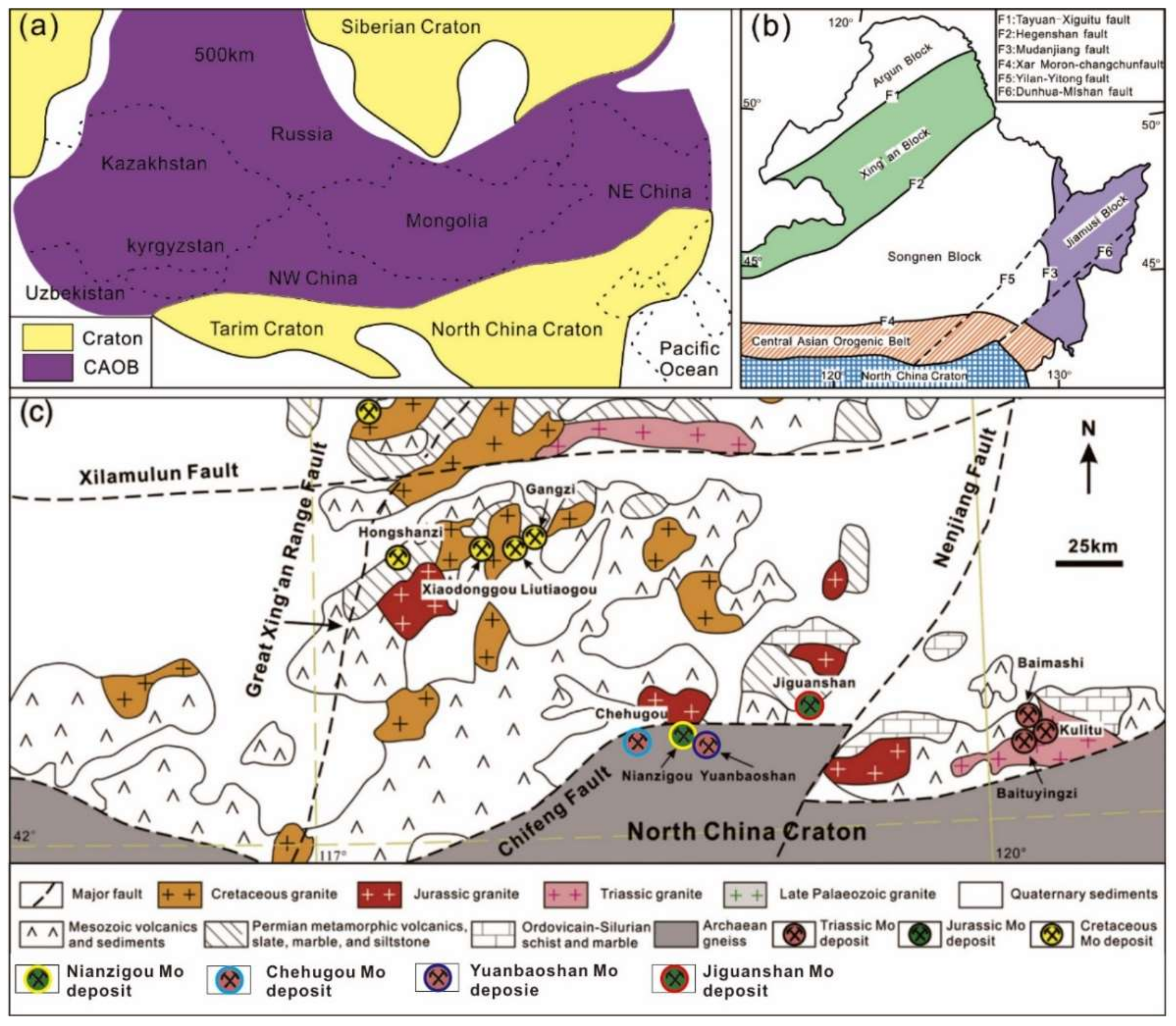
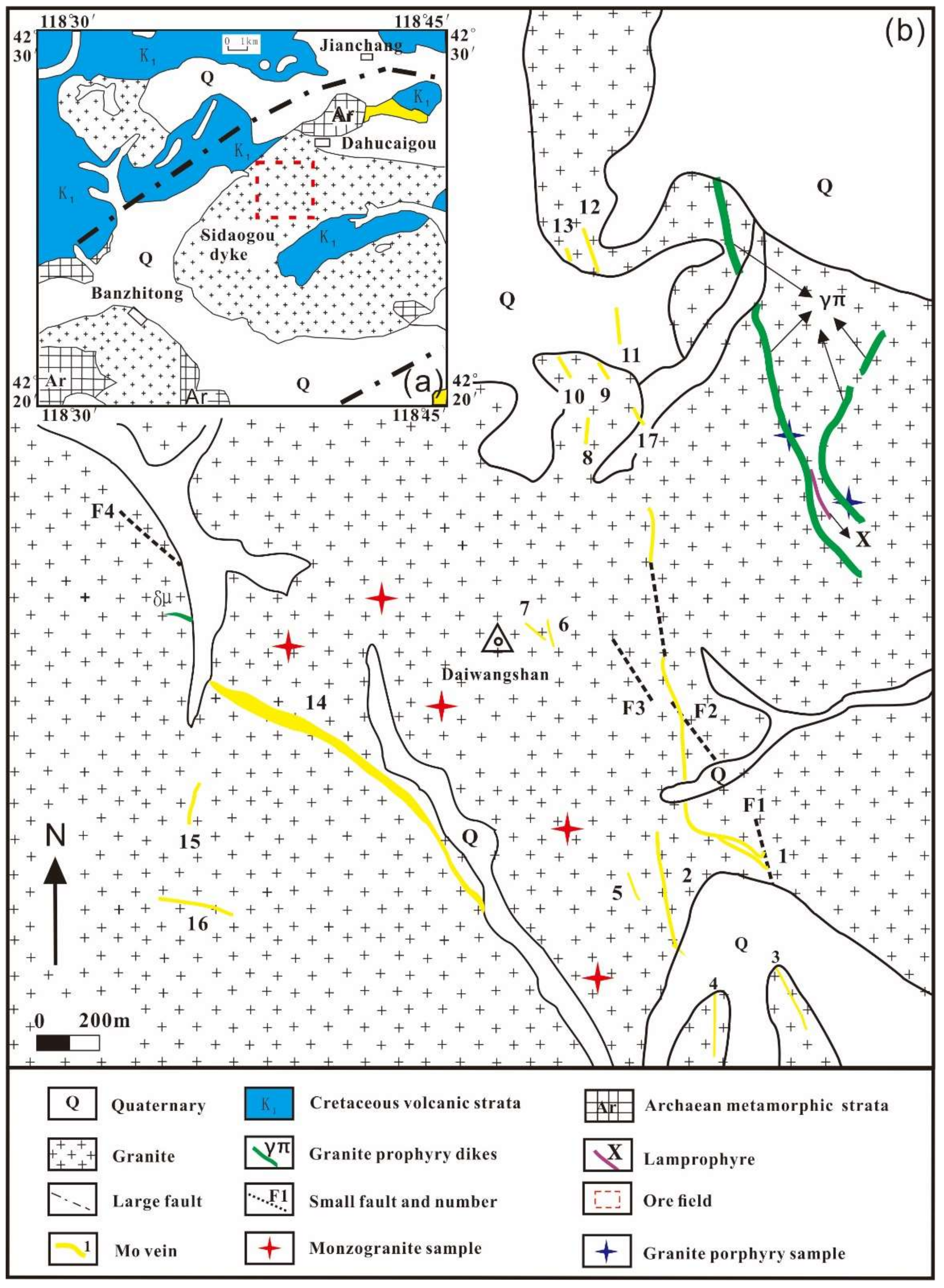
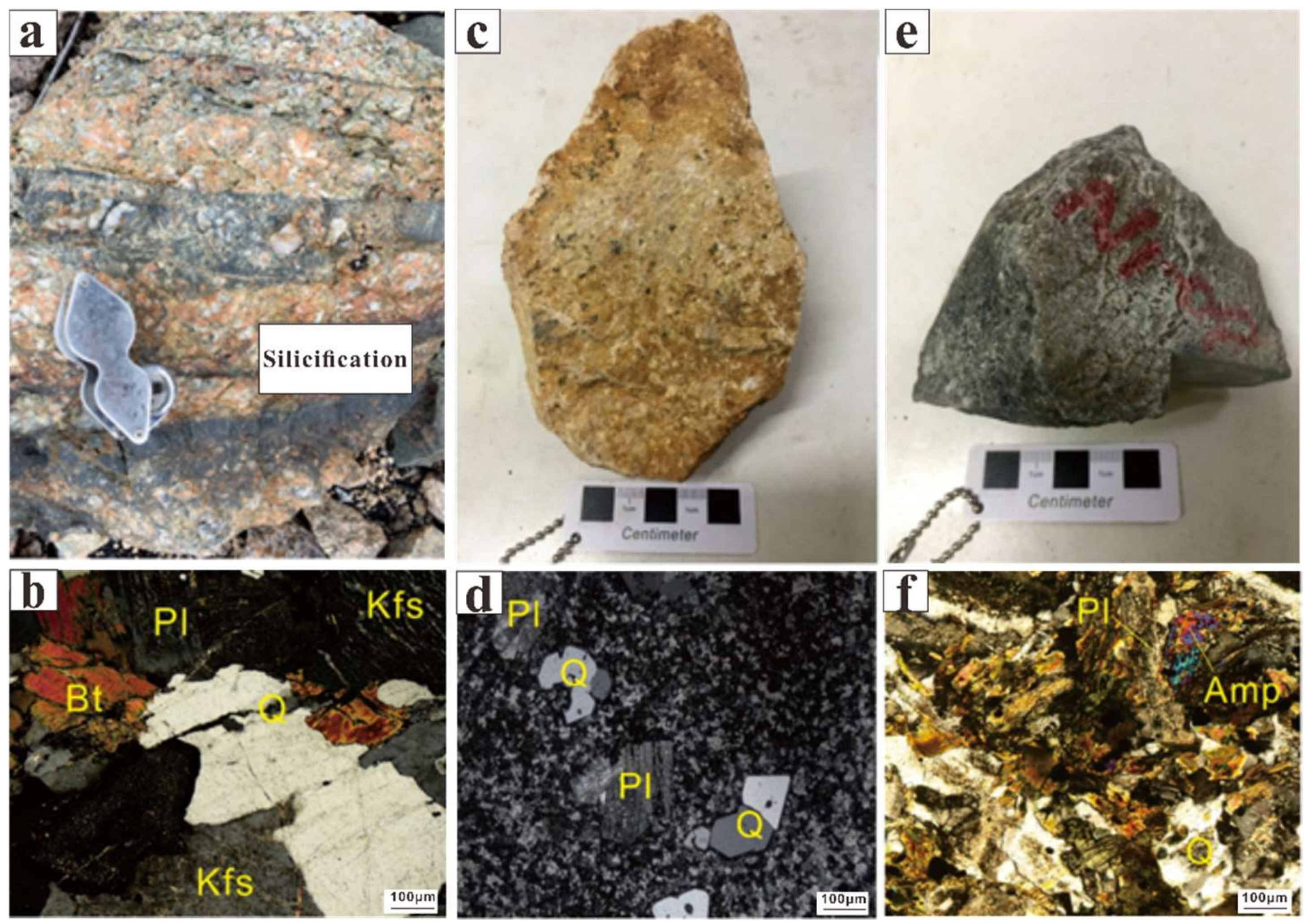
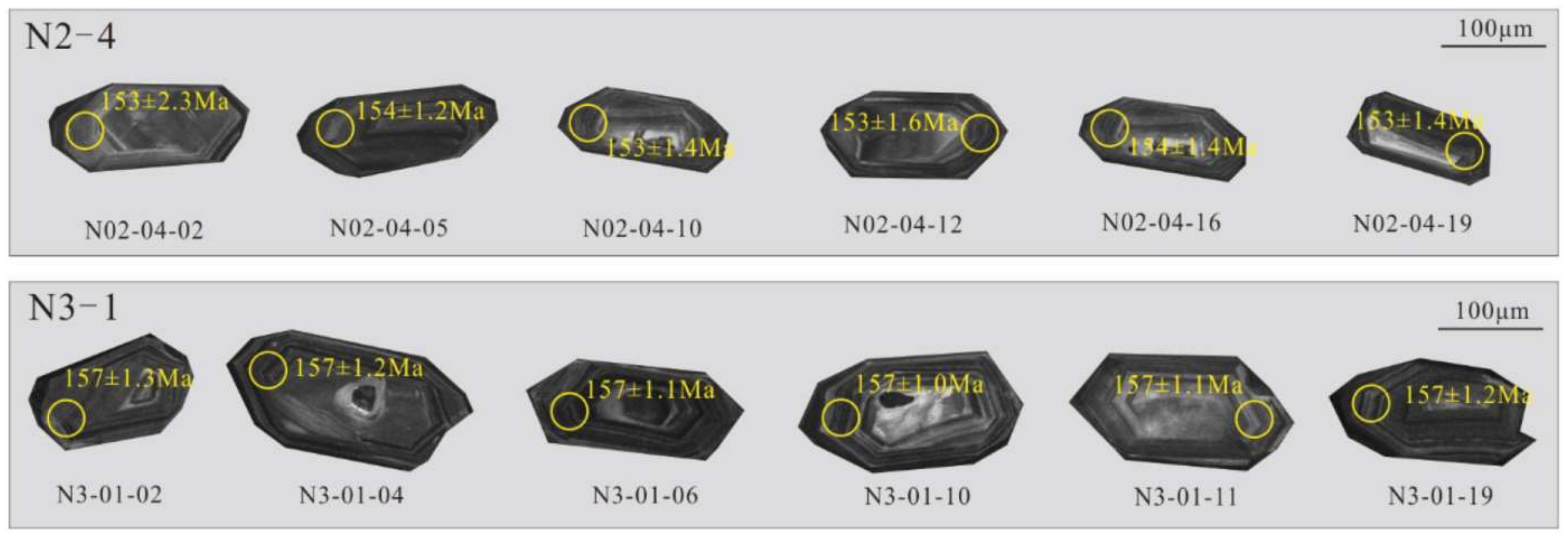
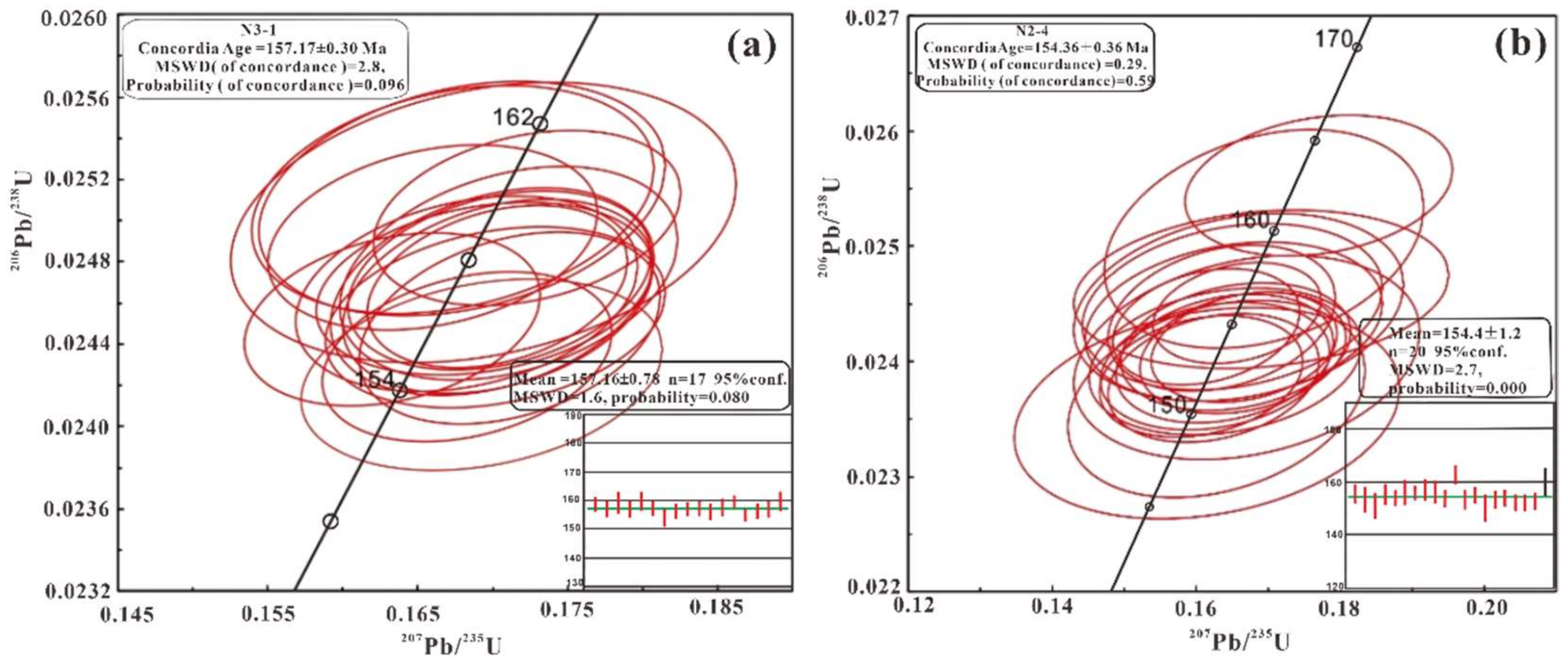
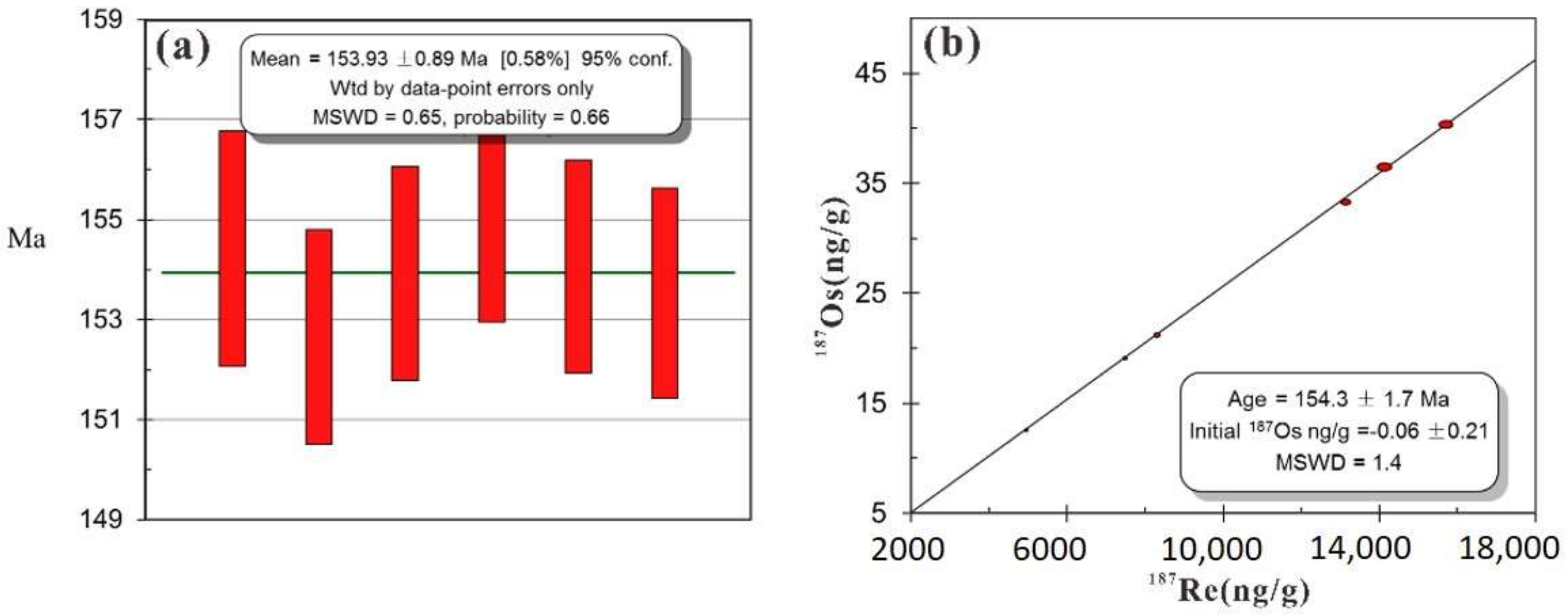
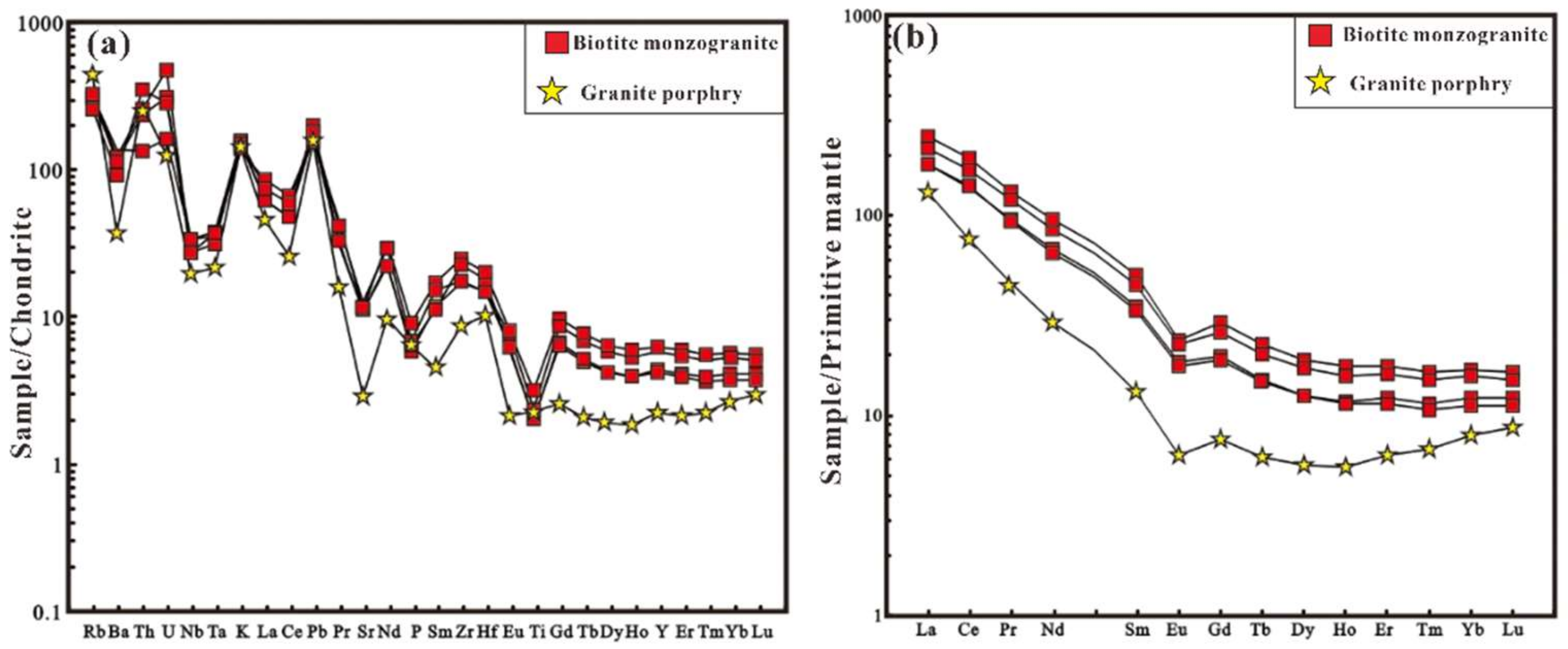
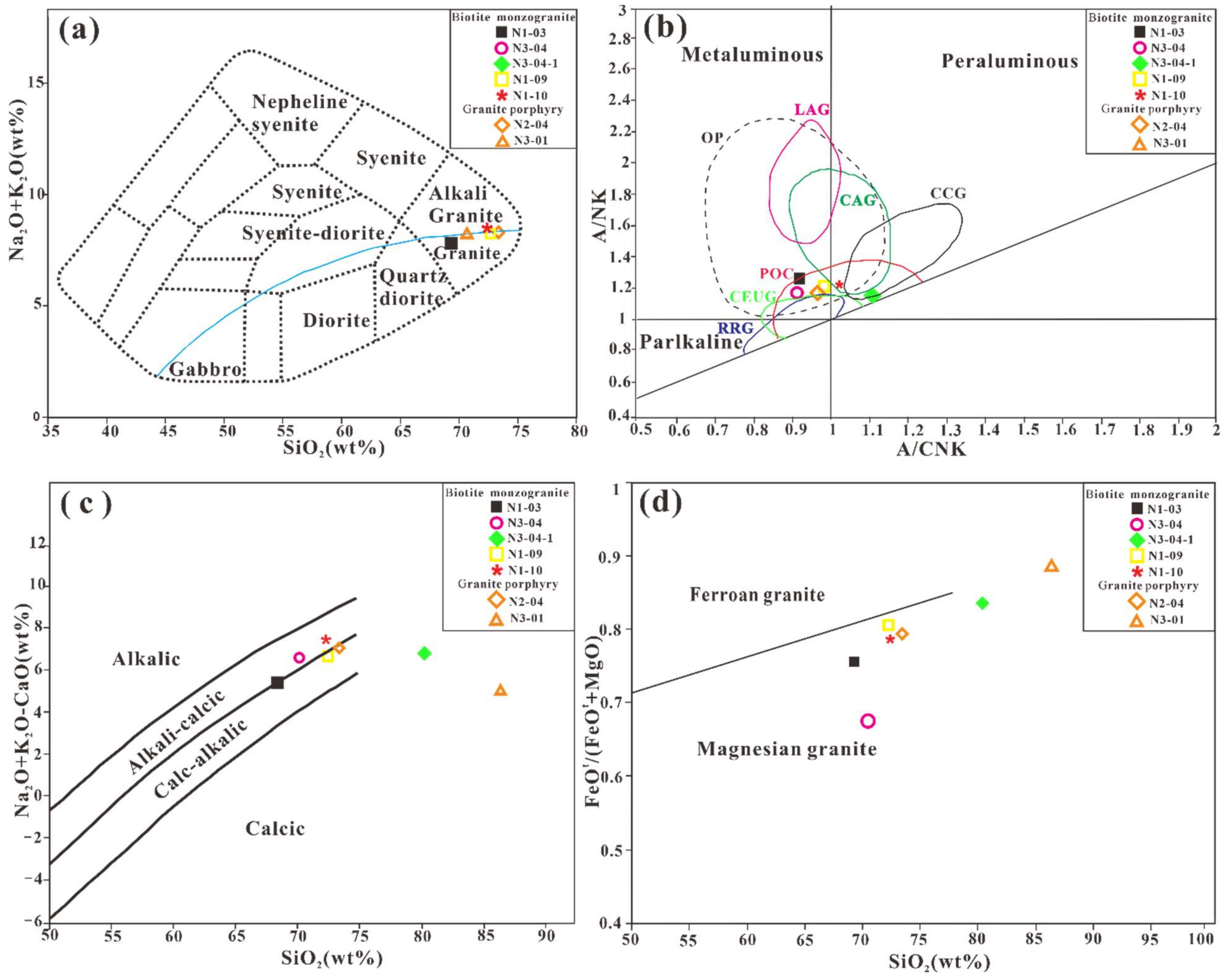
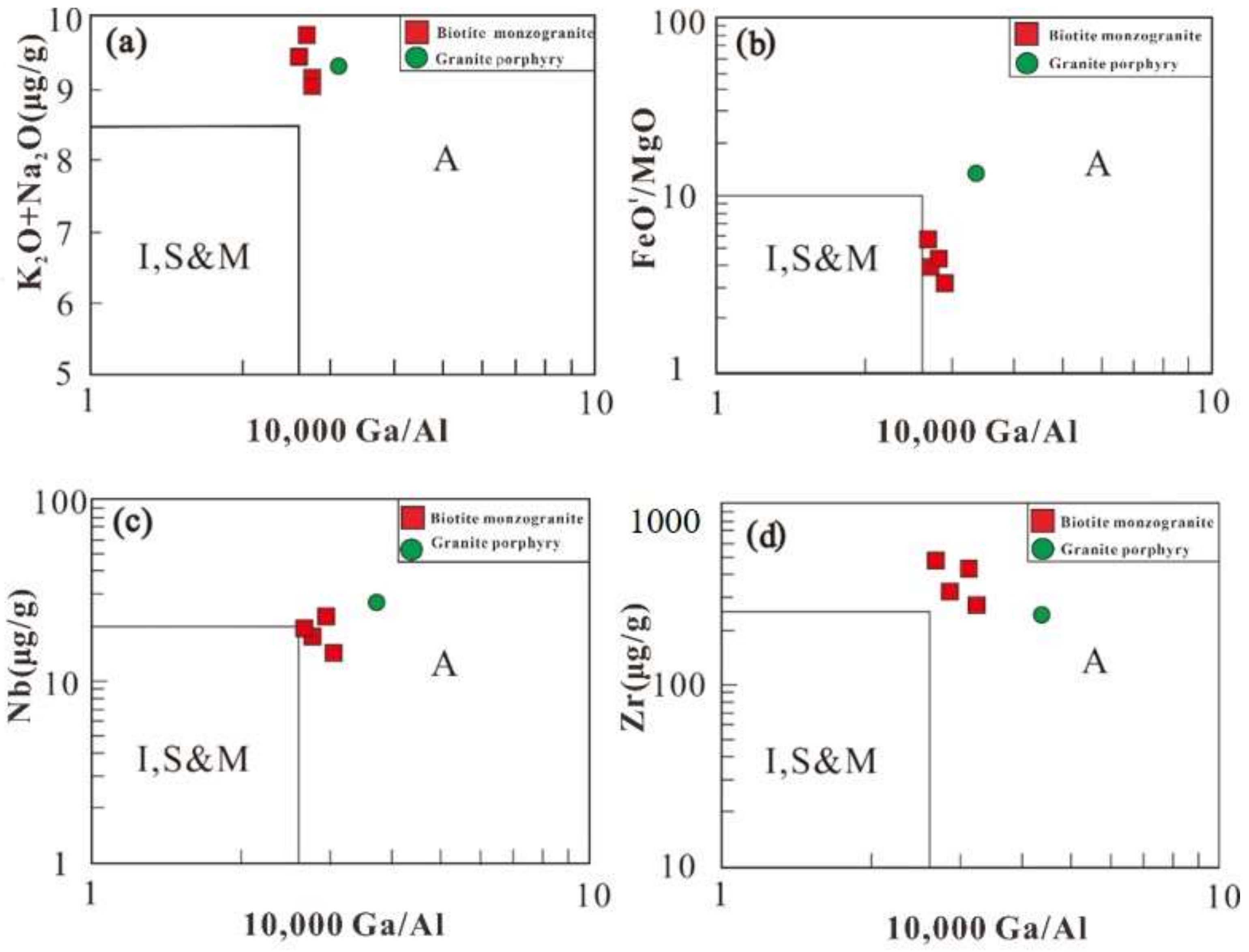
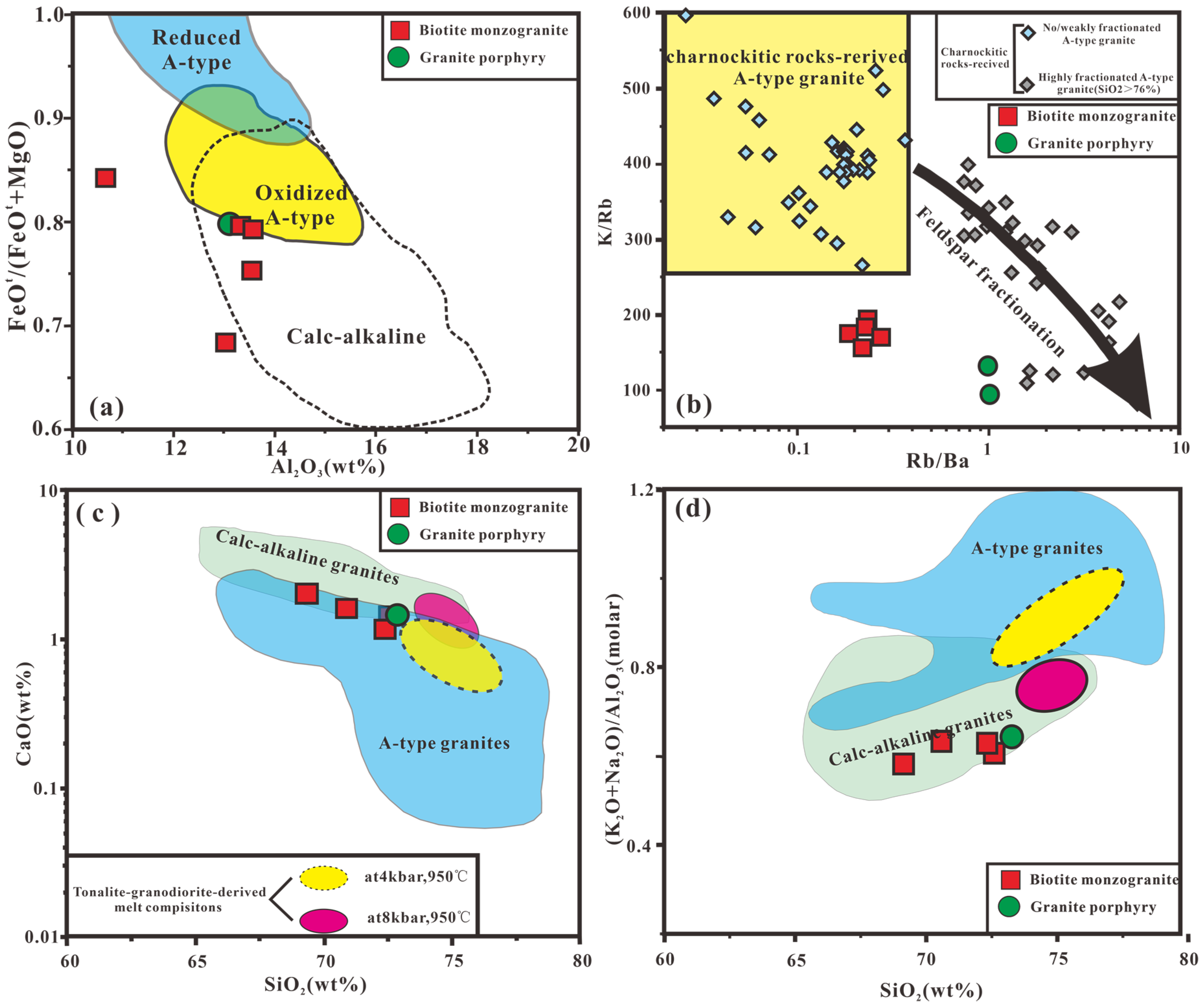
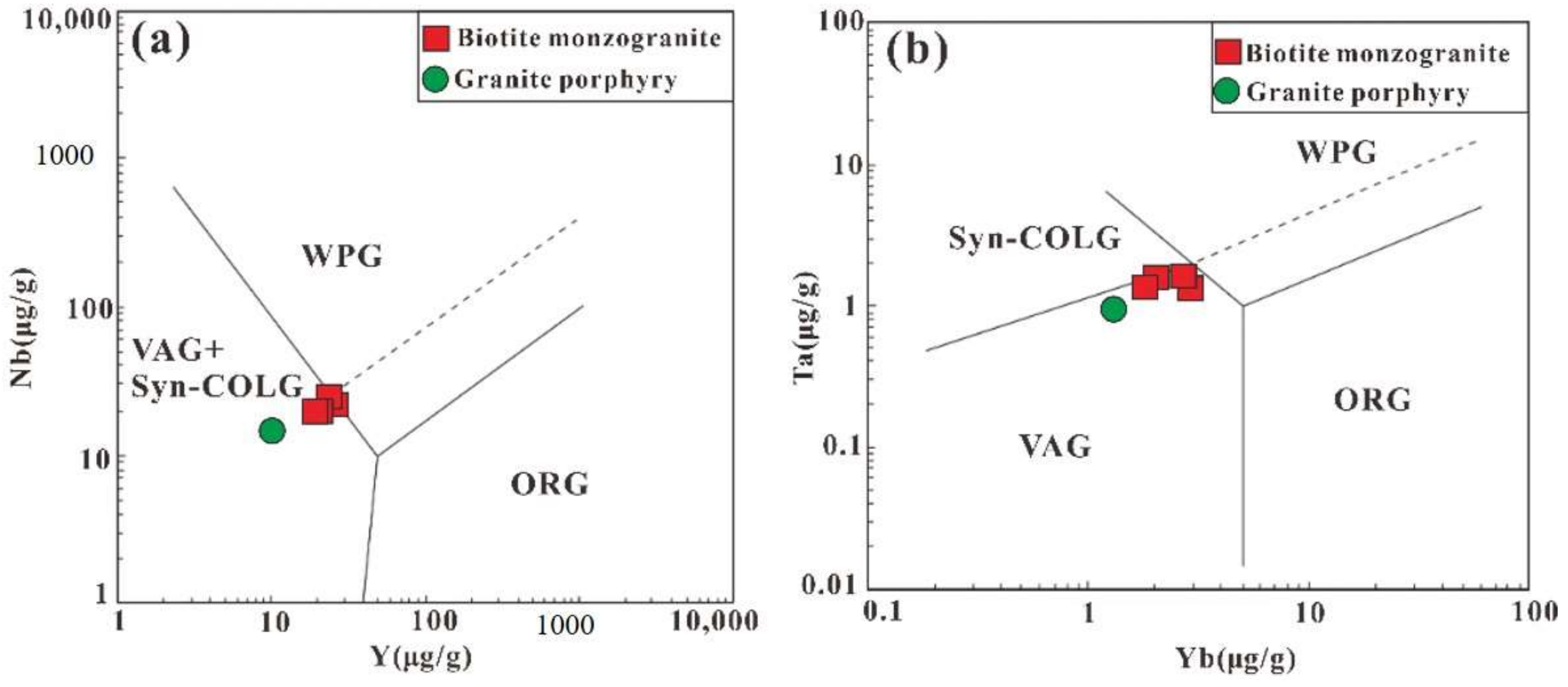
Publisher’s Note: MDPI stays neutral with regard to jurisdictional claims in published maps and institutional affiliations. |
© 2022 by the authors. Licensee MDPI, Basel, Switzerland. This article is an open access article distributed under the terms and conditions of the Creative Commons Attribution (CC BY) license (https://creativecommons.org/licenses/by/4.0/).
Share and Cite
Li, Y.; Yang, Y.; Hua, L.; Leng, Y.; Xin, J. Geochronology and Tectonic Implications of the Nianzigou Granites and Associated Mo Deposit, Inner Mongolia. Minerals 2022, 12, 791. https://doi.org/10.3390/min12070791
Li Y, Yang Y, Hua L, Leng Y, Xin J. Geochronology and Tectonic Implications of the Nianzigou Granites and Associated Mo Deposit, Inner Mongolia. Minerals. 2022; 12(7):791. https://doi.org/10.3390/min12070791
Chicago/Turabian StyleLi, Yang, Yongqiang Yang, Lei Hua, Yaxing Leng, and Jiang Xin. 2022. "Geochronology and Tectonic Implications of the Nianzigou Granites and Associated Mo Deposit, Inner Mongolia" Minerals 12, no. 7: 791. https://doi.org/10.3390/min12070791
APA StyleLi, Y., Yang, Y., Hua, L., Leng, Y., & Xin, J. (2022). Geochronology and Tectonic Implications of the Nianzigou Granites and Associated Mo Deposit, Inner Mongolia. Minerals, 12(7), 791. https://doi.org/10.3390/min12070791





